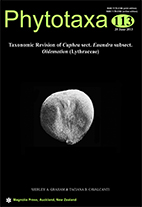Abstract
Cuphea sect. Euandra subsect. Oidemation comprises a non-monophyletic group of species defined by possession of a fire-resistant xylopodium. The xylopodium is a frequent feature of plants occurring in the seasonally and ecologically dry cerrados and savannas of South America. Subsect. Oidemation has diversified particularly in these habitats in eastern Brazil and adjacent Paraguay. Twenty species and five varieties are recognised: eleven species are endemic to Brazil; one each is endemic to Paraguay and Florida, USA; and seven are distributed in Brazil and adjacent areas of Bolivia, Paraguay, Uruguay and/or Argentina. Their morphology, including pollen and seed morphology, and chromosome numbers are reviewed. The presence of at least three major pollen types and two base chromosome numbers suggests the subsection is para- or polyphyletic; phylogenetic information based on molecular data for species of the subsection is limited. Diverse diploid, tetraploid, and hexaploid chromosome numbers point to polyploidy as an important mechanism of speciation in this group. A key to the species is accompanied by descriptions, illustrations and distribution maps.The subsection is lectotypified by C. retrorsicapilla and lectotypes are designated for C. acicularis, C. aspera, C. confertiflora, C. crulsiana, C. emarginata, C. enneanthera, C. excoriata, C. ferruginea, C. ferruginea var. acuminata, C. hyssopoides, C. remotifolia, C. retrorsicapilla, C. sperguloides, C. spermacoce var. angustata, and C. spermacoce var. elongata. A new combination is made for C. retrorsicapilla var. enneanthera.

